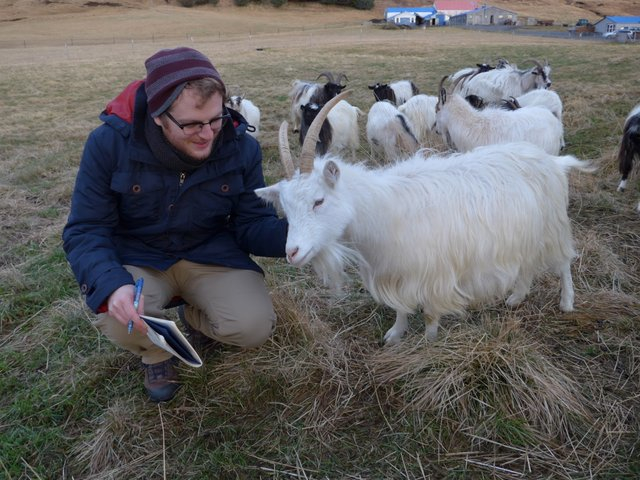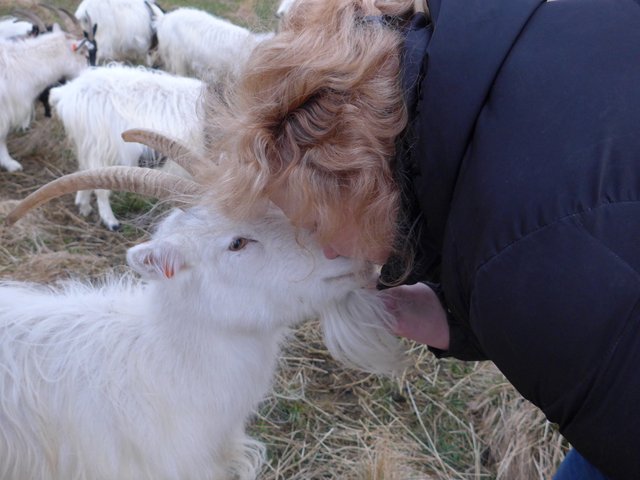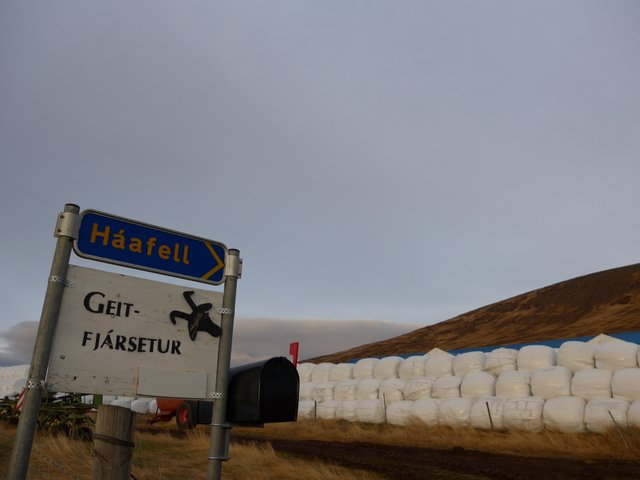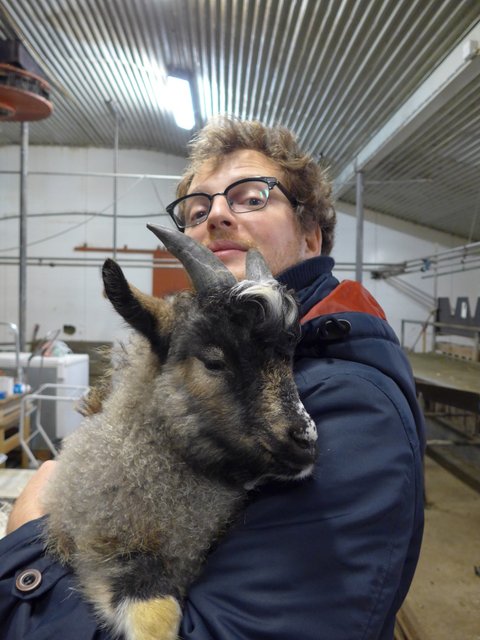It started in August, with a joke and a misunderstanding. An acquaintance of mine tweeted (sarcastically, I think, though I didn’t quite register it at the time): “FUCK YEAH, 28% WE GOT THIS, SAVE THE FUCKING ICELANDIC GOAT.” The words were followed by a link to what turned out to be an Indiegogo campaign titled “Save the Icelandic Goat From Extinction” and subtitled “Help Us Save the Goats From Game of Thrones!” Knowing that Game of Thrones does some filming in Iceland, I understood the “from” to mean that something the GoT production was doing or planning to do had somehow come into conflict with these goats’ ability to live. I imagined wild animals driven off their land by a pitiless corporate entertainment giant who would stop at nothing to get what it wanted. An avowed fan of both the show and the country—and being furthermore against extinction, as a general rule—it made me sad and alarmed to think that these factions found themselves at deadly odds.
I imagined wild animals driven off their land by a pitiless corporate entertainment giant who would stop at nothing to get what it wanted.
This was, of course, exactly wrong. These goats were “from” Game of Thrones in that they had appeared on it. I learned this as soon as I stopped freaking out long enough to scroll twice down the page, where there was a slightly blurry screen grab of Drogon, biggest and baddest of the three dragons belonging to Khaleesi Daenerys Targaryen, laying fiery waste to Casanova the goat, the face of the campaign. So the goats were alums, not victims, of Game of Thrones. As an Iceland-phile and a nerd (which may well be saying the same thing twice), I regarded this as very good news.
But what was the deal then with this extinction thing?

To understand the specific plight of the Icelandic goat, a bit of historical context is in order. Iceland is a very young land mass. There were never any indigenous people, and the largest native mammal is the arctic fox. It was settled in the late 800s, mostly by Norwegian Vikings and the Scottish, Irish, and British women they abducted to be their wives. The settlers brought cattle, sheep, chickens, pigs, horses, and goats. Centuries of careful husbandry—and/or indiscriminate inbreeding—conducted in the total genetic isolation afforded by a centuries-old ban on the importation of livestock have resulted in biologically distinct breeds of chicken, sheep, goat, and horse. Their horses are stumpy, wide, and pony-sized (though you’ll get yelled at if you call them ponies), and have a special additional gait that no other horse possesses. The goats are stumpy too, smaller and quieter than the Norwegian mountain goats from which they descend. The Icelandic goat—which can be white with horns, or brown and hornless—is a beautiful, friendly creature, and, under the right conditions, produces exquisite cashmere.
“The goat is important of course because we have very few mammals here in Iceland, but strangely the goat has few references in our known or recent culture—goats in folklore, goats in poetry, goats in Icelandic Sagas, are quite rare.”
But, getting back to the settlement era. To put it simply: Winter was coming. A small ice age that lasted from the 1200s to the 1500s caused the sheep to gain pride of place on the Icelandic farm. They produced wool, and milk and meat with a significantly higher fat content than goats (who also produce wool) or cows (who don’t), which perhaps sounds like a drawback to today’s reader, but if you were a Medieval subsistence farmer desperate to fatten yourself up against the relentless cold, you’d regard the fatty meat and milk as a feature, not a bug.
The goat’s reputation never recovered. The Icelandic people’s extreme pro-sheep bias is best represented by the country’s sole Nobel laureate, Halldor Laxness, in his masterpiece Independent People. For Bjartur of Summerhouses, the obstinate crofter at the center of the novel, farming is sheep farming. He’d rather see his whole family starve than suffer a cow on his land.

Johanna Thorvaldsdottir was born and raised at Haafell, a farm which sits at the base of a long low ridge, as though the mountain itself were cradling it in the crook of an arm. Johanna’s father—with what sounds like Bjartur-like willfulness—derided goats as being “for poor people,” and they were always forbidden in his day. The farm raised many kinds of animals, but its main focus was sheep. But Johanna always loved goats and dreamed of one day owning some of her own. (She also once went to a psychic who told her there were goats in her future.) She lived in Reykjavik for a time and worked as a nurse, but farming was always in her blood, so she and her husband, Thorbjorn Oddsson, moved back there in 1989. They raised six children, and countless sheep and chickens. As the new head of the household, she repealed her father’s ban and adopted a few goats that a friend of hers could no longer take care of. She thought of them as pets.

Johanna was aware that the Icelandic goat’s numbers were in precipitous, possibly irreversible decline. By the 1990s there were again fewer than 100 animals left. Then, in 1999, Johanna was offered the chance to adopt the last four brown hornless Icelandic goats on Earth. She felt touched by the hand of fate and decided to fully convert Haafell to a breeding farm for the Icelandic goat, with the express goals of preserving genetic diversity and getting the total population back up. The goats would pay their way with their products—milk, cheese, wool, meat, and more goats. Johanna would have to harness every market opportunity offered, but she would also have to create markets where there hadn’t been any for a long, long time.
This was a grand, and perhaps a foolhardy, scheme, but Johanna had ambition, heart, her family behind her, and a psychic’s prediction already half-realized. Then the government got involved. Because the four brown hornless goats came from a different part of Iceland, an agricultural regulation—which Joanna preferred not to dwell on, other than to curse its bureaucratic idiocy—barred her from selling any animal product of her farm for a whopping 10 years. This sounds to me—an admitted layman—like a needless and absurd precaution. But Johanna didn’t have any choice in the matter. The brown hornless goats were hers, and the farm was under quarantine.
Johanna used her lost decade to refine her breeding practice, and to start cultivating roses. She made some money from tourism, and some from semen sold to other breeders, though there aren’t many out there, and none of them work at anything close to the scale at Haafell. There are now about 800 Icelandic goats in the world; half of them are Johanna’s. Most other farms with goats only have five or 10; a few others have herds of 40 or so. But to be a proper breeding farm, you need at least 100 total animals, at least half females. “It’s so stupid,” she says. “Instead of giving us trouble the government should build up two or three more farms like this.”
So why don’t they? “The goat is kind of our neglected species,” says my friend Andri Snaer Magnason, an internationally renowned Icelandic novelist, poet, and environmental activist. “The goat is important of course,” he says, “because we have very few mammals here in Iceland, but strangely the goat has few references in our known or recent culture—goats in folklore, goats in poetry, goats in Icelandic Sagas, are quite rare.”Andri says that by the mid-1800s, the Icelandic goat population was down to about 100 animals. How and why it recovered from this brush with eradication is one of the vagaries of history, but there’s something miraculous about the fact that the Icelandic goat has hung on for as long as it has.
The central logic—and crime—of capitalism is to privilege the quantitative over the qualitative, to assign a zero where an infinity symbol belongs.
Just as Haafell farm was emerging from its quarantine period, the Icelandic economy was wiped out by the international banking crisis of 2008. This was the blow from which Haafell never quite recovered. You get the feeling, talking to Johanna, that there’s nothing she would have rather done less than ask strangers for charity, but by 2014, the farm was on the verge of foreclosure—not, notably, because of the enormous cost and difficulty of saving the Icelandic goat. That project had gone incredibly well and continues to be a success. It was the toxic combination of inflexible government bureaucracy and the insatiable (and, to this day, unpunished) greed of the international banking class that almost made this fiercely capable farmer lose her land—a parcel that has been in her family for generations and which constitutes her livelihood, her eventual pension, and her children’s futures.

If the Indiegogo campaign had failed and the farm was lost, Johanna’s goats would have been sent to slaughter. That would have immediately halved the total population and erased all the genetic diversity gained over the previous decade. Iceland would have been left with around 400 animals, without a breeding program to replenish their numbers. The Icelandic goat would have been, once again, as good as extinct.
Luckily, Game of Thrones was a huge profile raiser. Certainly, it was what first got my attention and caused me to share it with my girlfriend, who told some other friends of ours. I expect this is more or less representative of how the word spread. And sure, perhaps for some people the underlying motive was the putative absurdity of the cause itself (akin to supporting a guy making potato salad), but goats have this much in common with bankers: They can’t register irony. The money is either there or it isn’t. The farm either survives or it does not.
Johanna’s goal was $90,000, an almost pitifully modest sum in terms of the value of preserving a way of life or the existence of a species of animal—but that should hardly surprise anyone. The central logic—and crime—of capitalism is to privilege the quantitative over the qualitative, to assign a zero where an infinity symbol belongs. While interconnectedness at the level of these unchecked markets represents a global threat so toxic and vast as to be barely comprehensible, interconnectedness at the level of communication and awareness represents a powerful resource for people and communities who would otherwise suffer alone. And in the case of Haafell, the phenomenon worked. A loose and spontaneous agglomeration of pop culture junkies, cultural preservationists, foodies, Twitter ironists, fantasy nerds, environmental activists, and Iceland-philes from all over the world stumbled onto a common cause and rallied around it.

In the end, the campaign made $115,126. The extra money is going toward an on-site cheese-production facility that will help make Haafell sustainable. The last thing Johanna wants is to have to run another campaign like this. Another quirk of the global marketplace: If she can get to the point where she can export her organic artisanal goat cheese abroad, then it won’t matter whether Icelanders themselves want to eat the stuff or not.

About 4,000 people toured Haafell this year, and many of them left with goodies from Haafell’s gift shop. There are goat milk-based beauty products, T-shirts and hand towels emblazoned with the face of Casanova, little wooden figurines, and goat sausages. My girlfriend and I were in Iceland over Thanksgiving to do some research for a book I’m working on, and to hang out with Andri. We arranged to visit Haafell and collect our tour, which was the reward we’d chosen when we donated to the Indiegogo back in August.
All struggles over the past are in a real sense struggles over the future. Where Andri sees a history of relative unimportance, Johanna sees a long wrong to be righted, and a bright future ahead. What she wants, and needs, is for everyone else to see it too.
Haafell is and isn’t an easy place to get to. The directions are simple, but a bit vague, which is why we took Johanna’s own suggestion to go by GPS coordinates. This resulted in a drive off the main roads, through Thingvellir National Park, and eventually onto a gravel mountain lane, where we got stuck in a snow drift that was more than a four-wheel drive SUV could handle. I ended up running down the mountain to find someone who could tow us out, and then we were forced to turn around and head back to Reykjavik. On our second attempt, the following day, we actually made it to Haafell, which is set off on its own down a gravel road (no snow, thankfully) about a half-hour past Reykholt, a village where you can see Snorri Sturlasson’s favorite geothermal bath and not a whole lot else.
We were greeted warmly by a couple of farm dogs, and found Johanna inside the main house. She offered us tea and goat sausage. “Even babies can eat it, babies love it,” she told us as we sat at her table sipping tea and eating sausage as three of her grandchildren ran happily around.
To Johanna, the goat is one of the central players in Icelandic history and culture, even if Iceland doesn’t agree. She keeps a map of sites around the country that have the word “goat” in their name or are in some other way goat-related—a few dozen hills, here and there, from what I could tell. She adds to it as people send her entries, and the further word of her work spreads, the more entries come in.

On the subject of goat milk, Johanna is positively evangelical. Two weeks of goat milk will cure eczema in babies. She told us that a magnesium-and-goat-milk balm she makes has kept her feet utterly free of callouses and cracks. “Have you ever seen a farmer with perfect feet?” she asked me. I hadn’t, and in fact still haven’t, because it seemed indecorous to challenge her to take her shoes off and prove it.
I tried to square Johanna’s view with Andri’s, and couldn’t, but have come to believe that the disjunction itself is the point. All struggles over the past are in a real sense struggles over the future. Where Andri sees a history of relative unimportance, Johanna sees a long wrong to be righted, and a bright future ahead. What she wants, and needs, is for everyone else to see it too.
What Johanna showed us outside and in her barns was both more mundane and more powerful than I feel equipped to express here. Goats by the hundreds: eating, shitting, running, humping, sleeping, thriving. She gave us a baby goat to hold and we were each shocked at its utter ease and stillness in our arms. “Give it a few minutes,” she said, “and he’ll fall asleep.” He did. We also met the famous Casanova, who pranced and preened around a pen he has all to himself, as if he knew he’d not only saved the farm but become a cult figure in his own right.
There’s another goat, however, who stands out in my memory. He’s not famous, or even particularly friendly as Icelandic goats go. I don’t remember what his name is, if Johanna ever told us. He is a brown goat with horns, a combination long believed to be a genetic impossibility, but it turns out that the combination is merely highly recessive. It is, Johanna told us, the first one in a thousand years.
Lead photo by Amanda Bullock.





